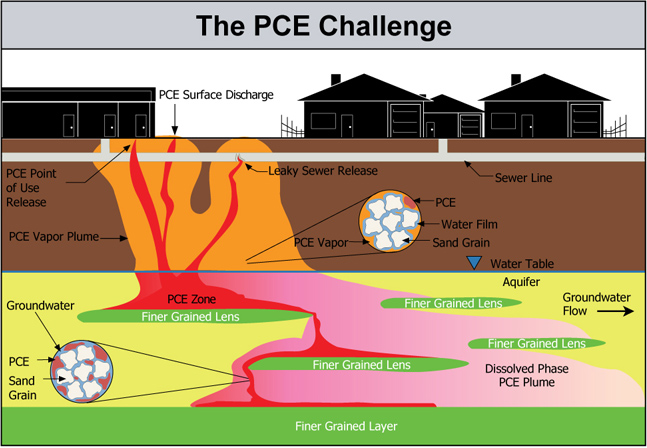Real estate professionals are generally aware of the risks posed by gas stations and tend to exclude these parcels or implement risk management strategies prior to acquiring title or control over properties containing these businesses. In contrast, the environmental risks of dry cleaners are often overlooked. Worse yet, dry cleaners tend to be small business with limited resources and usually do not have environmental insurance. As a result, dry cleaners are the leading source of environmental liability at commercial retail properties.
Real estate professionals are generally aware of the risks posed by gas stations and tend to exclude these parcels or implement risk management strategies prior to acquiring title or control over properties containing these businesses. In contrast, the environmental risks of dry cleaners are often overlooked. Worse yet, dry cleaners tend to be small business with limited resources and usually do not have environmental insurance. As a result, dry cleaners are the leading source of environmental liability at commercial retail properties.
 How Prevalent are Contaminated Dry Cleaner Sites?
How Prevalent are Contaminated Dry Cleaner Sites?
Dry cleaners generate relatively large volumes of hazardous substances-EPA estimates the average dry cleaner generates 660 gallons of hazardous wastes a year. Moreover, due to poor housekeeping, dry cleaners have historically had a high frequency of spills and discharges. Some notable facts:
- Studies by EPA, the State Coalition for Remediation of Dry Cleaners (SCRD) and others have estimated that 75% of the approximately 30,000 dry cleaners currently in operation have contamination (i.e., 22, 500 actively contaminated sites);
- Over 150 dry cleaners are listed in the EPA CERCLIS and over 200 dry cleaners appear in the New York environmental remediation database;
- EPA estimates there may be an additional 9,000 to 90,000 former dry cleaner sites that likely present a significant risk of contamination;
- Studies by California Water Boards in 1992 and 2007 found that dry cleaners are a major contributor to groundwater contamination;
- A 1992 California Water Board study found that the leading cause of dry cleaner contamination was wastewater discharges to sewers and septic systems;
- A 1999Montana study found dry cleaners discharges to sewers were a leading cause of groundwater contamination;
- A 2002 Florida study found that dry cleaner contamination had migrated off-site at 57% of the contaminated sites;
- A 1999 Lawrence Livermore National Lab study the median dry cleaner plume length was approximately 1600 ft while SCRD found the average; plume to be 1270 feet. EPA reported that the 90th percentile plume length was 2585 feet and that 89% of dry cleaner plumes exceeded 100 feet.
To see maps depicting long dry cleaner plumes, click here;
- The dry cleaner cleanup is between $400K to $500K but can range up to $3MM. EPA estimated that the total national cleanup cost for dry cleaners could approach $7.6 billon.
Toxic Tort Liability
In addition to remediation costs, contaminated dry cleaner sites can expose property owners to significant toxic tort liability because these business tend to be located in densely populated areas, the contaminants do not easily degrade, are highly volatile and can migrate considerable distances so that the contamination can pose a risk of vapor intrusion to residences, schools and other buildings located above the plumes.
.Due Diligence Challenges
Historic dry cleaners pose a particular risk to property owners because the former operations used considerably more solvents and the equipment in use at that time resulted in numerous spills. However, it can be challenging to determine if dry cleaners operated in the past much less determining which one was responsible for the contamination.
Click here for information on where spills at dry cleaners commonly occur.
Click here for more detail on the diligence challenges involved with historic dry cleaners
Click here and here for blog posts discussing recent cases involving historic dry cleaners.
Dry Cleaner Funds- Do Not Be Fooled!
A dozen states have established dry cleaner programs that will fund investigation and remediation of dry cleaners. Program eligibility, the scope of liability relief and funding is highly variable. Indeed, SCRD estimates that these state trust funds will only be able to finance cleanups at 5,000 sites.
Purchasers, lenders, environmental consultants and real estate lawyers often find false solace if a site has been enrolled in a state dry cleaner program and has been assigned a low priority. However, most state programs prioritize sites based on impacts to drinking water and do not take vapor intrusion into account when ranking sites for funding priority. Thus, while owners may be sitting back waiting for their sites to receive funding, vapors from the migrating plume could be wafting into residential neighborhoods or in into other sensitive tenant spaces such as day care centers or schools.
Click here for more information about state dry cleaner programs
While current dry cleaners use significantly less solvent and equipment that is less prone to leaks, improper maintenance and operational practices can still result in releases to the environment. Property owners should ensure that dry cleaning tenants use best management practices such as having solvent-grade epoxy floor coating and secondary containment for the drum storage areas as well as the dry cleaning equipment.
